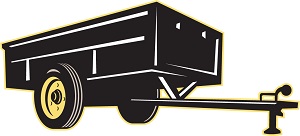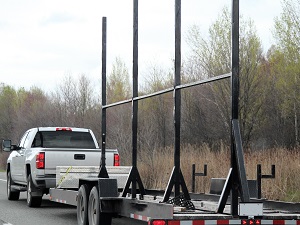If trailers are used to tow materials or other cargo on the job, it's important that workers are aware of towing safety precautions to ensure the safest drive possible.

Before towing a trailer with any vehicle, it’s important to perform a few checks first. Be sure to consult the vehicle’s owner’s manual for the specifications of these items as well as any other requirements your vehicle might have when it comes to towing a trailer.
Confirm that the towing vehicle is rated for the load you expect to carry. Check the tire pressure of the tow vehicle. When towing, a higher tire pressure may be required. Because towing puts additional stress on a vehicle, ensure the maintenance is up-to-date.
Incorrectly sized hitch balls are a common cause of trailer accidents, so make sure the ball on the tow hitch is the same size as the coupler on the trailer. The hitch balls typically come in 3 sizes: 1 7⁄8 inches, 2 inches, or 2 5⁄16 inches. Also, pay attention to the weight capacity of the hitch ball.
Always confirm that the equipment used to connect the trailer to the tow vehicle is properly fitted, secured, and adjusted. The hitch, tow vehicle and ball must have a rated towing capacity equal to or greater than the weight of the trailer and the cargo combined.

Before loading up and pulling out with a trailer in tow, it’s essential to perform an all-around inspection of the trailer you will be using.
Trailer Tires. Make sure all the tires are set at the correct tire pressure. Inspect the tires for dry rot and cracking, especially if the trailer is normally stored outdoors or hasn’t been used in several months. Ensure there is at least one spare tire available for the trailer, along with a lug nut wrench and a jack, just in case you need to change a flat tire on the side of the road.
Safety Chains. Confirm the safety chains are hooked up to the hitch and crossed over each other. If the trailer gets disconnected from the tow vehicle, the crossed chains will catch the trailer tongue. The safety chains should not drag on the road but should have enough slack for turns.
Trailer Brakes. If the trailer is equipped with brakes, adjust them according to the load. Set the brakes to use more force when towing a heavy load and adjust the brakes to a lighter weight when pulling an empty trailer.
Trailer Lights. With a partner, visually confirm that all of the trailer’s lights are connected and working properly.

Trailers loaded incorrectly can start swaying dangerously at high speeds and can easily jackknife if the driver has to make a sudden stop. Load the trailer in a way that distributes the weight evenly and ensures that the cargo is equally balanced on each side.
The cargo should all be fully contained and supported by the flatbed trailer. If the cargo being transported by the trailer is longer than the trailer itself, or overhangs off the trailer in any way, be sure to check your state’s regulations on overhang restrictions and requirements.
OSHA Standard 1926.21(b)(2) The employer shall instruct each employee in the recognition and avoidance of unsafe conditions and the regulations applicable to his work environment to control or eliminate any hazards or other exposure to illness or injury.
All cargo on the trailer should be tied down and secured so there is no risk of the cargo shifting or tipping over. All materials being transported on a trailer should be completely immobilized by appropriately applied tie-downs so there will be no horizontal or vertical movement at all when the trailer is on the road. All tie-downs must be secured in such a way that will prevent them from loosening or opening during travel.
Confirm that the trailer, as well as the load, falls within the towing capacities of the vehicle. Never overload in such a way that exceeds the weight capacity of the trailer.

All cargo on the trailer, large and small, must be secured well enough so there is no risk of movement when the trailer is in motion.
Inspect all tie-downs for wear and damage. If any restraints are frayed, defective or damaged, do not use them. Do not use bungee cords or tarp straps as the primary method of securing the load.
Tie-downs and securing devices must not contain knots. Each tie-down must be secured in a manner that prevents it from becoming loose, unfastened, opened, or releasing while the vehicle is in transit. Edge protection must be used whenever a tie-down would be subject to abrasion or cutting at the point of contact with the cargo.
Remember, you are securing the load for sudden stops and evasive action, not just for normal driving conditions. Consider each individual item on the trailer and make sure everything is secured in such a way so that nothing will leak, spill, blow off, tear apart, tip over or fall from the trailer.
After loading, confirm that the cargo does not cover the license plate, lights or reflectors and it does not obstruct the driver’s view in any way. Cargo straps can loosen during travel with the vibrations of the road, so early in the trip and regularly throughout the drive, pull over safely and check that everything continues to remain fully secured on the trailer.

Once the trailer is loaded and the cargo is secured, take some time to consider safety precautions of driving with a trailer before hitting the road.
Use a spotter when backing up with a trailer. Even wider mirrors don’t always provide full visibility and it is better to be safe especially when there are other vehicles, objects or people close by.
Make wider turns at curves and corners because the trailer wheels will end up closer to the inside of a turn than you are used to normally and are more likely to hit or ride up over curbs.
The added weight of the trailer will increase stopping distances. Stay well behind the vehicle in front of you and begin braking sooner than you normally would if you weren’t towing a trailer.
Trailers, or what’s being towed, may be taller than your vehicle, so keep the height clearance in mind when pulling into gas stations or passing under a low bridge.
Stay in the right lane on the highway to make it easier to pull over to the shoulder if ever you need extra stopping room or happen to have a tire blowout. Allow plenty of room when changing lanes and passing other vehicles.
Take every precaution to avoid slamming on the brakes and making abrupt turns because sudden movements can shift the trailer cargo. If the trailer begins to sway while driving, ease off the accelerator to reduce your speed but do not apply the brakes, as this can make the sway become worse.

.jpg)

